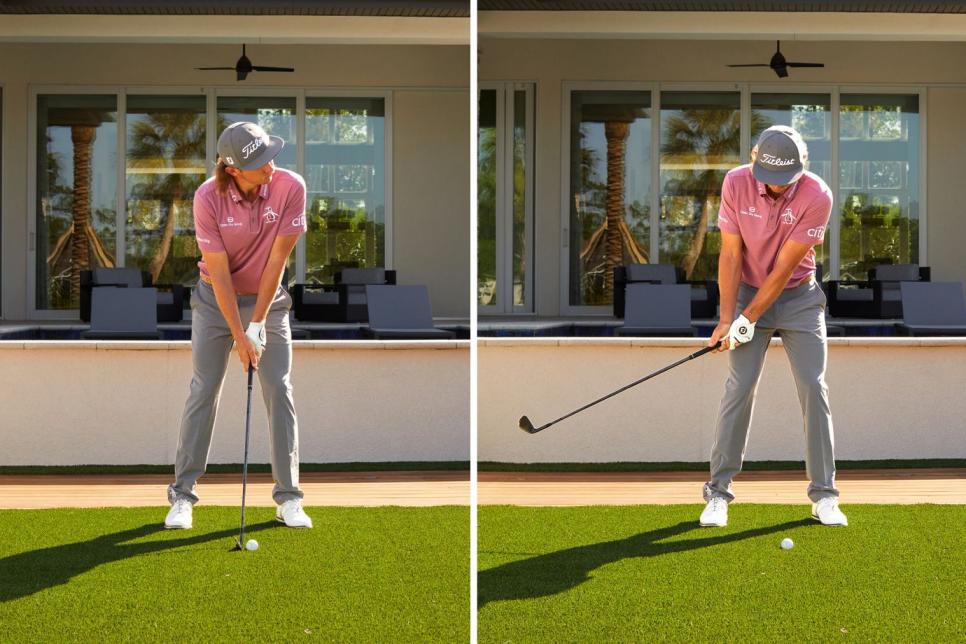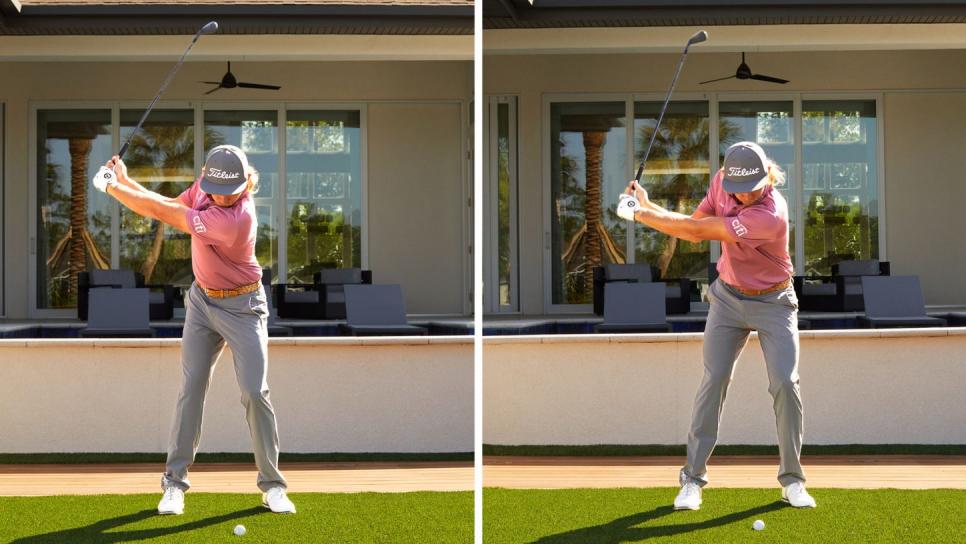Tempo, Tempo, Tempo
Go With the Flow: Cameron Smith's tips to put some smooth in your swing

Photographs by Michael Schwartz
I grew up in Australia, and because of the wide variety of courses and climates across the country, I learned how to play good golf in many different conditions. I think that’s why having a consistent, natural tempo to my swings became a big thing of mine. It’s easy to let things get pear-shaped when you’re playing in a different environment than you’re used to. Sometimes it’s not even the golf course or the weather. It could be the weight of the moment—a big match or the last few holes of a tournament—that throws you off your game. It’s those times when getting back to swinging with good tempo matters most.
It’s hard to explain what good tempo is, but here in my backyard, I’m going to do my best to demonstrate three key areas of my full swings and talk about the things I’m feeling that help create good motion going back and through. Using my putting green, I’m also going to offer some help with tempo for your short game. It’s definitely something I think about when I’m pitching, chipping and even putting. Whenever I’m playing with my mates and they want a quick tip, I always go back to tempo and swinging in sync—especially as you start to take the club back. Let’s start there, and then I’ll help you smooth out the rest. —With Ron Kaspriske
START OFF CONNECTED

When I get out of sync, it usually starts with a bad move in the first quarter of the swing. My arms go back first, the club gets away from my body, and then I have to make this loopy action to try to match things up by impact. What I want to feel is “connected,” trying to get my body to move as one unit as I start the swing (above, right). I know I’m moving better when I start to feel weight loading into my right heel. Get the first bit of the backswing right, and you generally make a much better stroke.
FLOW FROM THE TOP

This area of the swing, from nearly the top of the backswing (above, left) to the first move down (above, right), is where a lot can go wrong, especially for amateurs who get a lot of cast at the top. Cast means you’re trying to hit the ball immediately as you start down-casting the clubhead away from the body with some wrist action, instead of letting the club release closer to the ball. When you reach the top of the backswing, you’ll know you can start down if things feel solid and together—the body and arms stopping at the same moment. Then, the transition should feel like you’re in no rush. A good thought is to let your arms drop down in front of your body as you start the downswing. From there, you can just rotate your body, and you’re in position for a good move through the ball.
RELEASE RIGHT BEFORE IMPACT

The casting move might be the result of nerves, anxiousness or just wanting to hit the ball hard. You have to resist that urge by keeping a smoother pace swinging down. Don’t get me wrong—your club should be picking up speed, but you don’t have to whip it down from the top. Save your speed for the zone just before and after impact (above), and make sure nothing feels jerky or out of sorts with the tempo you’ve created from the start. Do it right, and the ball will jump off the face. The shot will feel effortless.
CHIPS AND PITCHES: PRETEND THE BALL IS NOT THERE


Ever notice how smooth your stroke feels when you’re rehearsing swings around the greens, but when it comes time to hit the shot, you tend to produce something quick and jabby? I see that a lot when I watch ams chip and pitch. I’m not sure why that is, but it might be because you’re trying to strike the ball and get it off the ground, instead of making a swing through it that lets the club do the work (above). Maybe harder done than said, but it might help if you pretend the ball is not there when you swing. That thought should get you closer to copying your smoother practice swings.
STICK YOUR FINISH

Quick greens might tempt you to quit on your stroke through the ball. Long, slow putts might make you want to take a smack at the ball. Neither tendency is going to make you a better putter. What will? Having the same tempo on every stroke, no matter the putt. I try to make every stroke with a 2-to-1 ratio in time from backswing to impact. You can practice that with some internal cadence, even just thinking one, two going back and three going forward—whatever helps re-create the same tempo. The goal is a full release of the putterhead, getting it to stop square to my line after the ball is struck (above). If you’re picking up on a theme here, I’m not hitting at the ball—I’m stroking the putterhead through it. If you take only one swing thought from all this talk about tempo, no matter the shot, I hope it’s that.


